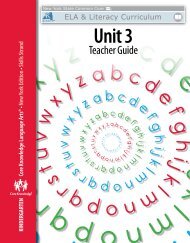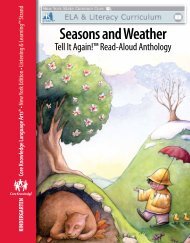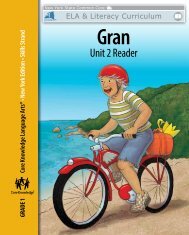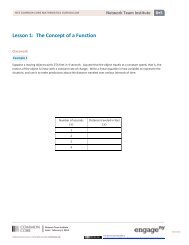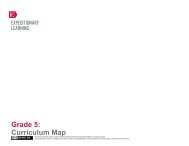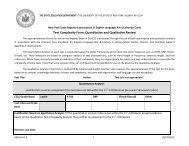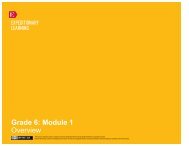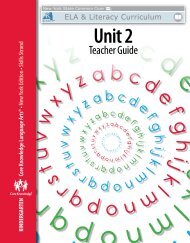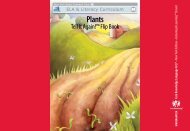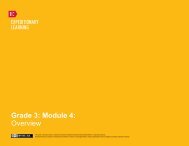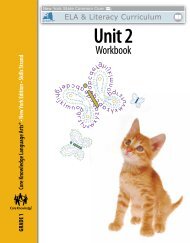- Page 1:
Grade 2 Core Knowledge Language Art
- Page 4 and 5:
Creative Commons Licensing This wor
- Page 7 and 8:
Alignment Chart for Westward Expans
- Page 9 and 10:
Alignment Chart for Westward Expans
- Page 11 and 12:
Alignment Chart for Westward Expans
- Page 13 and 14:
Introduction to Westward Expansion
- Page 15 and 16:
What Students Have Already Learned
- Page 17 and 18:
• Identify and locate the Louisia
- Page 19 and 20:
Student Performance Task Assessment
- Page 21 and 22:
5. Dancing Teepees: Poems of Americ
- Page 23 and 24:
32. Clara Morgan and the Oregon Tra
- Page 25 and 26:
Audio with video 6. “The Erie Can
- Page 27 and 28:
Core Vocabulary campfire, n. An out
- Page 29 and 30:
Show students Image Card 3 (Louisia
- Page 31 and 32:
Presenting the Read-Aloud 15 minute
- Page 33 and 34:
loaded onto a flatboat and carried
- Page 35 and 36:
cattle struggle to breathe and we h
- Page 37 and 38:
Discussing the Read-Aloud 15 minute
- Page 39 and 40:
Going West 1B Extensions 20 minutes
- Page 41 and 42:
Mr. Fulton’s Journey 2 Lesson Ob
- Page 43 and 44:
Introducing the Read-Aloud Mr. Fult
- Page 45 and 46:
6 or water vapor 7 What do you thin
- Page 47 and 48:
Show image 2A-8: Map showing two ri
- Page 49 and 50:
Word Work: Voyage 5 minutes 1. In t
- Page 51 and 52:
Westward Expansion Quilt (Instructi
- Page 53 and 54:
Write simple sentences to represent
- Page 55 and 56:
Introducing the Read-Aloud The Jour
- Page 57 and 58:
Presenting the Read-Aloud 15 minute
- Page 59 and 60:
Discussing the Read-Aloud 15 minute
- Page 61 and 62:
Use a Making Choices activity for f
- Page 63 and 64:
Song: “The Erie Canal” (Instruc
- Page 65 and 66:
they should write a word or short p
- Page 67 and 68:
Recount a personal experience with
- Page 69 and 70:
Introducing the Read-Aloud The Stor
- Page 71 and 72:
Presenting the Read-Aloud 15 minute
- Page 73 and 74:
12 Do you think it would be difficu
- Page 75 and 76:
3. Inferential Why did Sequoyah fee
- Page 77 and 78:
The Story of Sequoyah 4B Extensions
- Page 79 and 80:
4. writing a letter (That is a way
- Page 81 and 82:
The Trail of Tears 5 Lesson Object
- Page 83 and 84:
Introducing the Read-Aloud The Trai
- Page 85 and 86:
Presenting the Read-Aloud 15 minute
- Page 87 and 88:
13 The Trail of Tears is what peopl
- Page 89 and 90:
4. While camping in the woods with
- Page 91 and 92:
Take-Home Material Family Letter Se
- Page 93 and 94:
Student Performance Task Assessment
- Page 95 and 96:
Key Vocabulary Brainstorming Materi
- Page 97 and 98:
Riddles for Core Content Ask studen
- Page 99 and 100:
Lesson Objectives Westward on the 6
- Page 101 and 102:
At a Glance Exercise Materials Minu
- Page 103 and 104:
Oregon Territory. As you share this
- Page 105 and 106:
7 [Point to the ruts in the image.]
- Page 107 and 108:
Show image 6A-12: Abigail greeting
- Page 109 and 110:
25 Where will home be for these pio
- Page 111 and 112:
Word Work: Territory 5 minutes 1. I
- Page 113 and 114:
the scout. Ask students what they t
- Page 115 and 116:
Rehearse and perform poems, stories
- Page 117 and 118:
or talk about something, but it als
- Page 119 and 120:
Show image 7A-3: Fast horses runnin
- Page 121 and 122:
up in the distance. Can you imagine
- Page 123 and 124:
5. Inferential Why were the young m
- Page 125 and 126:
The Pony Express 7B Extensions 20 m
- Page 127 and 128:
Lesson Objectives Working on the 8
- Page 129 and 130:
At a Glance Exercise Materials Minu
- Page 131 and 132:
power his boat, Peter Cooper of New
- Page 133 and 134:
Show image 8A-5: Map of the two com
- Page 135 and 136:
Show image 8A-8: Ling Wei working i
- Page 137 and 138:
8. Evaluative Think Pair Share: Why
- Page 139 and 140:
Working on the Transcontinental Rai
- Page 141 and 142:
Dinah, won’t you blow your horn?
- Page 143 and 144:
The Buffalo Hunters 9 Lesson Objec
- Page 145 and 146:
Introducing the Read-Aloud The Buff
- Page 147 and 148:
Presenting the Read-Aloud 15 minute
- Page 149 and 150:
12 or seriously he remembered to lo
- Page 151 and 152:
7. Inferential What was the “iron
- Page 153 and 154:
The Buffalo Hunters 9B Extensions 2
- Page 155 and 156:
Domain Review DR Note to Teacher Yo
- Page 157 and 158:
4. The most famous route for settle
- Page 159 and 160:
• I am the animal that the Lakota
- Page 161 and 162:
7. Route: The way we get from one p
- Page 163 and 164:
Culminating Activities CA Note to T
- Page 165 and 166:
• The Pony Express was an overlan
- Page 167 and 168:
Poetry Reading Find a copy of the p
- Page 169 and 170:
For Teacher Reference Only: Copies
- Page 171 and 172:
1B-1 Name Directions: Cut out the q
- Page 173 and 174:
5B-1 1B-2 Dear Family Member, Durin
- Page 175 and 176:
5B-1 1B-3 Recommended Trade Books f
- Page 177 and 178:
27. Robert Fulton, by Lola Schaefer
- Page 179 and 180:
Websites and Other Resources Family
- Page 181 and 182:
2B-1 Name Directions: Cut out the q
- Page 183 and 184:
3B-1 Name The Erie Canal This popul
- Page 185 and 186: 3B-1 cont. Name 2. We better get on
- Page 187 and 188: 3B-2 Name Directions: Cut out the q
- Page 189 and 190: 4B-1 Name Directions: Cut out the q
- Page 191 and 192: 5B-1 Name Directions: Cut out the q
- Page 193 and 194: 5B-2 Dear Family Member, For the pa
- Page 195 and 196: PP-1 Name Directions: Listen carefu
- Page 197 and 198: PP-1 Name Answer Key Directions: Li
- Page 199 and 200: PP-2 Name Directions: Think about w
- Page 201 and 202: 7B-1 Name Directions: Cut out the q
- Page 203 and 204: 8B-1 Name I’ve Been Working on th
- Page 205 and 206: 8B-1 cont. Name Westward Expansion
- Page 207 and 208: 8B-2 Name Directions: Cut out the q
- Page 209 and 210: 9B-1 Name Directions: Cut out the q
- Page 211 and 212: 9B-2 Name Directions: Cut out the q
- Page 213 and 214: DR-1 Name Directions: Put a number
- Page 215 and 216: DR-1 Name Directions: Put a number
- Page 217 and 218: DR-1 Name Answer Key Directions: Pu
- Page 219 and 220: DR-1 Name Answer Key Directions: Pu
- Page 221 and 222: DR-2 Name Directions: Study the map
- Page 223 and 224: DR-2 Name Answer Key Directions: St
- Page 225 and 226: DA-1 Name Directions: Listen carefu
- Page 227 and 228: DA-1 Name Answer Key Directions: Li
- Page 229 and 230: DA-2 Name Directions: Listen to eac
- Page 231 and 232: DA-2 Name Answer Key Directions: Li
- Page 233 and 234: DA-3 Name Directions: Read each que
- Page 235: Tens Recording Chart Use this grid
- Page 240: Westward Expansion Tell It Again! R



